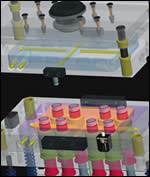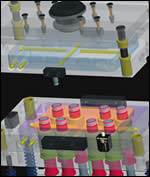How to Gain a Better Understanding of the Complete Business Case Impacting the Tooling Purchase
By starting with five key business strategies, a structured process will identify how you can evaluate where you are today, the opportunities to improve and the factors that significantly impact your ability to compete.
In today’s rapidly changing plastics world, the hard reality is that loyalty means nothing, and more company executives make decisions to address shareholder pressures. While we can sit back and critique their decisions, that is not the answer. A proven approach is to be proactive with management decision makers and finance executives. This equates to higher profits resulting from gains in productivity through implementation of sound processes that improve the molding environment. For a moldmaker, this means having a better understanding of the complete business case that impacts the tooling purchase. Simply put, it’s not just the capital budget for tooling that is important.
Sorting through Your Customer’s Needs
Beyond building a tool, it is understanding the short- and long-term customer goals, quality needs, domestic versus global requirements, shot guarantees, penalty clauses and their customer’s expectations for performance and quality, etc. These are the first questions that should be asked—whether you are a moldmaker, molder or OEM.
Five Key Business Strategies to Consider
Starting with five key business strategies and the related questions to consider, a structured process identifies how you can evaluate where you are today, the opportunities to improve and the factors that significantly impact your ability to compete.
The process starts by reviewing and documenting the following:
1. Teaching moldmakers how to evaluate real savings (the importance of intangibles).
- What are your real job-to-job costs (i.e. steel, labor, over-head, etc.)?
- What can be done differently (i.e. process, manufacturing, procurement, etc.)?
- Dare to be different. Quoting isn’t a business. It costs money. Qualify those RFQs. Ask the right questions to ensure you’re not a “check bid”.
- Sell beyond the mold. (i.e. demonstrate your approach to finding new solutions, your experience as it relates directly to the application and the customer needs will capture decision makers sooner in the process).
2. Breaking down of the cost elements that a shop actually controls.
- Do you really understand how the competition is quoting?
- Have you put a cost to quoting?
- Have you evaluated your win/ loss ratio?
- How have you streamlined your procurement process for materials and contracted services? If you have, do they target areas in your operation that can make a real difference to your bottom line profitability (i.e. consolidation of like services and reduction of supply chains)?
- Understand your manufacturing process. Have you identified specific technologies that can reduce your costs while adding value to your customers (i.e. evaporative cooling technology for mold temperature control)?
3. Questions you need answered when considering a change to your business model.
- What makes your tool different (i.e. unique design logic that allows for reduced size in tooling while maintaining required cavitation)?
- Identify your “value add proposition” (i.e. what is it in your process that helps your customers improve their ability to compete).
- Can you effectively explain today how and why a mold is not a commodity (i.e. what is your business argument that will catch the attention of management)?
4. Defining a “technology partner” and what that means to today’s moldmaker. What can you gain from seeking out “technology partners?”
- Given the cost pressures, where does the creativity and innovation come from (i.e. internal capacity or select outside technologies that have specializes expertise)?
- What technologies can impact the mold design, performance and long-term use (i.e. mold cooling, use of simulation software, mold controls, materials used that correlate to life expectancy of tool or product)?
- Is it possible to expect (internally) to be always up to date with technology?
- What commitment do you have in place for IP, R&D and innovation?
- Leveraging an objective outside party can bring a fresh approach to your business strategy. They focus on helping you inc-rease your customer base; you focus on the business of building superior tooling solutions.
5. What a moldmaker should understand about process optimization. Making sure the tool you designed will perform beyond expectations.
- Does the tool design take full advantage of the customer’s molding environment (i.e. machine compatibility, handling equipment setup, mold controls)?
- What expectations do you have of the tool/product in the field (i.e. does it actually correspond to what your customers expect)?
- What follow-up is routine after delivery (i.e. is the tool setup to the same parameters as the tool was designed for? If not, the mold performance could be diminished.)?
- Do you know the status of the tool one, two, three years after shipment (i.e. do you benchmark how the tool is running, so that proactive maintenance can be implemented)?
Differentiating Yourself: The Time to Act
What is interesting is that the five considerations and related questions also apply to molders and end user OEMs to a considerable extent. So regardless of where you are in the overall molding process, the same approach to evaluation applies. That’s good for you because it means that your customers are faced with the same business-driven realities.
So now you understand what your customers’ needs are. You’ve identified technologies that can add value and you need to implement as soon as possible. The key is to act on informed decisions and to implement the new approach to building a complete solution. The benefit is your ability to proactively promote and inform your customers about how you are incorporating leading-edge technologies that offer clear advantages in cycle, part quality and reliability.
For example, as reported in the December 2006 issue of MoldMaking Technology (page 19), an evaporative cooling approach to mold temperature control has been proven through several years of in field use. New to North American moldmakers and processors, the technology is gaining recognition and is one example of how to provide that elusive ability value add for your customers, while reducing your tool manufacture costs.
The biggest single challenge faced by moldmakers is the acceptance of having to go through a more strategic approach to positioning the true value of the tools that they design and build. Business on a hand shake unfortunately won’t win the type of long-term accounts needed to sustain your business.
The Potential Result of “In-Action”
For lack of a different comparison, it really becomes a race now between suppliers to embrace new technology solutions and then take them to your customers proactively. If you wait until your customers become self-informed and request the technology from you, you lose that all-important ability to differentiate yourself, other than being on a comparative level of experience.
Thoughts to Take Away
The preceding discussion points represent the highlights of what is required to help develop sound business strategies that will empower you to compete. Not surprisingly, it takes a significant amount of time to debate internally with customers. Interesting enough, if employees are asked separately, the disconnect between focusing on the manufacturing of a tool versus what it will take to differentiate a moldmaker in today’s market, is apparent. Hence, the need is often for a third-party, objective perspective. A proactive approach takes the above framework, works to hone in on key parameters, then strategically implements the utilization of advancements in technology to help achieve your goals, and those of your customers.
In phase two of the strategic plan, a technical marketing plan is established to help leverage the new technology platform into new business, new customers and expanded market penetration. Lastly, a staff of seasoned experts in processing optimization work to ensure that the tools are running optimally, year after year with measurable gains in margin. Companies can appoint an internal champion to lead this all-important activity if available within, or elect to have an outside party lead and then train staff moving forward.
Summary
Changing your business is tough, but embracing a systematic and measurable approach to change will ensure your ongoing ability to compete and service the North American market. If nothing else, consider these two important points: (1) think hard, real hard, about leveraging new technologies and partners and then act to implement; and (2) dare to be different and lead your customers before the pricing pressures associated with being a commodity supplier lead you into negative margins.
Related Content
How to Improve Your Current Efficiency Rate
An alternative approach to taking on more EDM-intensive work when technology and personnel investment is not an option.
Read MoreDynamic Tool Corporation – Creating the Team to Move Moldmaking Into the Future
For 40+ years, Dynamic Tool Corp. has offered precision tooling, emphasizing education, mentoring and innovation. The company is committed to excellence, integrity, safety and customer service, as well as inspiring growth and quality in manufacturing.
Read MoreSteps for Determining Better Mold Prices
Improving your mold pricing requires a deeper understanding of your business.
Read MoreMaking Mentoring Work | MMT Chat Part 2
Three of the TK Mold and Engineering team in Romeo, Michigan join me for Part 2 of this MMT Chat on mentorship by sharing how the AMBA’s Meet a Mentor Program works, lessons learned (and applied) and the way your shop can join this effort.
Read MoreRead Next
Don’t Build the “Same Old Same Mold”
Steps for evaluating the latest mold innovations in order to move along the evolution process.
Read MoreHow to Use Continuing Education to Remain Competitive in Moldmaking
Continued training helps moldmakers make tooling decisions and properly use the latest cutting tool to efficiently machine high-quality molds.
Read MoreHow to Use Strategic Planning Tools, Data to Manage the Human Side of Business
Q&A with Marion Wells, MMT EAB member and founder of Human Asset Management.
Read More
















